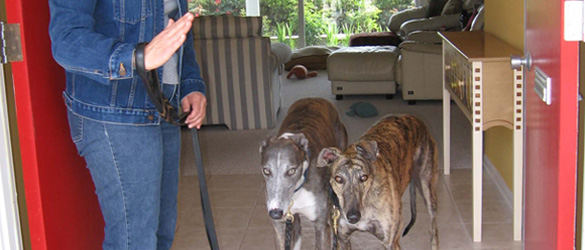Teaching a greyhound to have some patience is much easier said than done, I know! When my husband Mark and I adopted our two current grey-babies Manx and Corsa, we were abruptly reminded just how lightening fast and spry the young ones are!
Our previous two hounds Phoenix and Nubi lived to the wonderful proud old ages of 12 and 13 respectively and they passed away within six months of each other. Suffice it to say that we had spent years and years perfecting our daily “dance” with those two and even though they were senior citizens, they could still wick it up a notch when they wanted to! Their manners were wonderful and they spoiled us dearly.
Going from Phoenix and Nubi to Manx and Corsa was quite an eye opener to say the least! Manx and Corsa were both two years old when we adopted them and they did everything but sleep fast! That took a lot of getting used to. It had been such a long time since we experienced the raw zeal of track babies in our daily lives. In light of this, my new favorite cue of all time has become “wait.” “Wait” is a great management tool that is really useful and easy to teach too. “Wait” teaches the dog that patience pays off and it also reinforces your leadership position.
First of all, to teach “wait” you need a defined boundary. The threshold of your front door works nicely as does a curb at the intersection of two streets. I know I don’t have to tell you this but before you begin, put the leash on your dog and hold on tight!
Let’s use the front door example. With your dog securely on leash, open the front door. Practice working this boundary by repeatedly approaching the open door and before you get to the threshold, give a gentle friendly “tug-tug” on the leash while you say the cue “wait!” The only rule for “wait” is that the dog cannot cross the boundary (e.g. go through the doorway) until you give the go ahead by a cue such as “OK!” Your main focus needs to be making sure the dog does not charge through the doorway. The dog needs to stay on your side of the boundary. So, after you approach the door and gently tug tug on the leash while you say, “wait” chances are your dog will look up at you which is the perfect time to tell he or she what a great dog they are in a happy voice! A good duration for a “wait” moment is three to five seconds or so. When you go to try this, be sure your dog is not too far out in front of you, that would make it more cumbersome for all involved. Position yourself within a foot or two from the end of their darling little nose! That way you will be able to maintain control and not let them cross the boundary. When you are ready to cross the boundary use the word “OK!” and let your dog go through the doorway. Then you can tell them “good job!” Now you are outside and you can go for a fun walk.
I use “wait” all the time with my dogs on our regular walking route. We live in a neighborhood with curbs and sidewalks and speeding drivers. So before we cross any street, at every intersection I have the dogs “wait!” Now they are getting really good at it and they actually turn their heads and look up the street we are about to cross for traffic! Mama’s SO PROUD! After ten or so drills on “wait” your dog will have the hang of it. Your task is to be a consistent leader and use your new “wait” cue to keep your pups on the safe side of boundaries.
We’ve mentioned the front door and street intersections as great places to teach and use “wait.” Other uses of “wait” include: getting out of the car (they always want to rush that one!), other doors to the outside world like patio screen doors, gates, etc…. You will find many uses for this great management tool once you start using it.
One thing to note with regard to more formal training is that “wait” is completely different than the cue “stay.” With “wait” the only thing the dog should not do is cross the boundary. They can do whatever they want to on their side of the boundary like stand, sit, lay, howl, you name it AS LONG AS THEY DO NOT CROSS THE LINE until you say OK. The cue “stay” is associated with more formal exercises where the dog needs to maintain the exact position given along with the cue “stay” such as “sit+stay”, “stand+stay”, “down+stay”.
You can’t have too many tools in your toolbox when it comes to managing your dogs I always say! I hope you have fun working on “wait” and teaching your sweet dog(s) an easy great management tool for developing patience and improving manners.
Genie Tuttle, CPDT-KA has been training dogs of all breeds for over 25 years and a greyhound owner for over 15 years (presently Corsa and Manx.) She has earned the Certified Professional Dog Trainer (CPDT-KA) credential, the first independently issued credential for dog training. She is also a member of the Association of Professional Dog Trainers (APDT.) Genie can be reached at: genie@doggenie.com.
Published in the November 2006 edition of Greyt Times newsletter, the official publication of the Homestretch Greyhound Rescue and Adoption.
(Borrowing from Letterman here)
Dog Genie’s Top 10 List of Good Leader Habits:
10.
Don’t be a push-over! (easier said than done)
9.
“Structure” is not equal to being a “meanie”
8.
In nature, dogs earn their keep. Nobody brings them dinner on a silver platter.
7.
Teach your dog a simple behavior they can do to “pay” for resources (e.g. sit or stay)
6.
Have your dog earn precious resources (as they define them)
5.
A consistent predictable routine works best
4.
Do not overreact
3.
Dogs like to be mentally stimulated (learning, training)
2.
A good leader is a balanced leader (not too strict, not too easy)
1.
Life is Good, Enjoy It!

